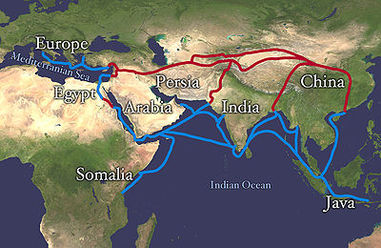
REGIONS
The silk road is a vast trading route that stretches from China to Europe. Over time there were many different countries that became the directors of the silk trade and different countries that had the best market for silk.
Japan was the largest consumer for silk from China. This whole trade system was the Portuguese initiating the intra-Asian trade for silk. However, for a period of time Japan was a silk producer. The silk was very high quality. with the Portuguese initiating the intra-Asian trade for silk. In the 19th century it was proven that the silkworm eggs from Japan were resistant to the rare diseases which, as confirmed in a report by Louis Pasteur in 1865, saved the silk industry in Europe. Japan and France had a good relationship that revolved around silk trade. France was a major center for textile and silk industry in the 18th and 9th centuries. At one point the purchases of silkworm eggs and raw silk from Japan by France made up for more than half of the worlds population.
Rome had the highest demand for silk. The market was so large that at times the Senate attempted to ban the import with the fear of running short of gold. The Romans exchanged their gold for silk, so much of it that silk was sometimes perceived as a sign of decadence and immortality. Overall Europe had a very high demand for silk which was controlled by certain countries that directed the trade. The Europeans were the middle man to getting the silk to the New World which was a huge improvement.
The silk road is a vast trading route that stretches from China to Europe. Over time there were many different countries that became the directors of the silk trade and different countries that had the best market for silk.
Japan was the largest consumer for silk from China. This whole trade system was the Portuguese initiating the intra-Asian trade for silk. However, for a period of time Japan was a silk producer. The silk was very high quality. with the Portuguese initiating the intra-Asian trade for silk. In the 19th century it was proven that the silkworm eggs from Japan were resistant to the rare diseases which, as confirmed in a report by Louis Pasteur in 1865, saved the silk industry in Europe. Japan and France had a good relationship that revolved around silk trade. France was a major center for textile and silk industry in the 18th and 9th centuries. At one point the purchases of silkworm eggs and raw silk from Japan by France made up for more than half of the worlds population.
Rome had the highest demand for silk. The market was so large that at times the Senate attempted to ban the import with the fear of running short of gold. The Romans exchanged their gold for silk, so much of it that silk was sometimes perceived as a sign of decadence and immortality. Overall Europe had a very high demand for silk which was controlled by certain countries that directed the trade. The Europeans were the middle man to getting the silk to the New World which was a huge improvement.

